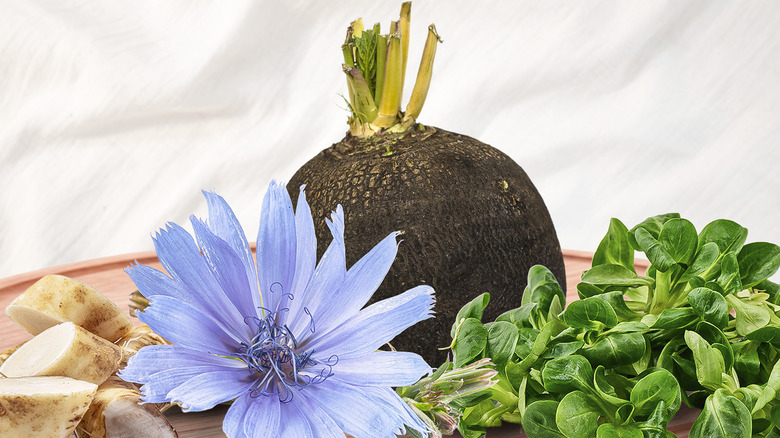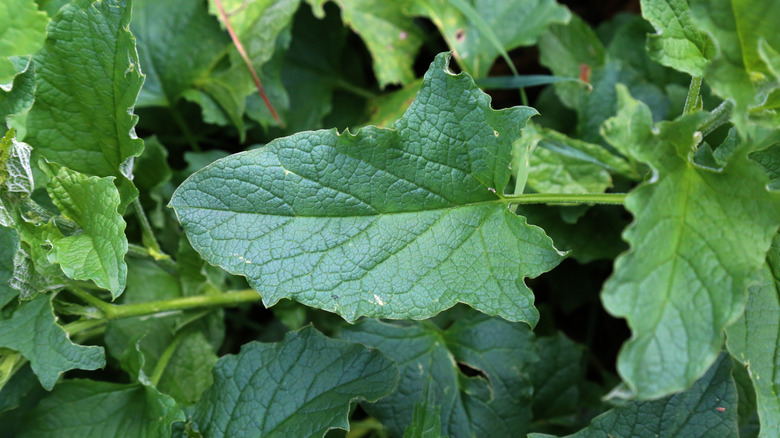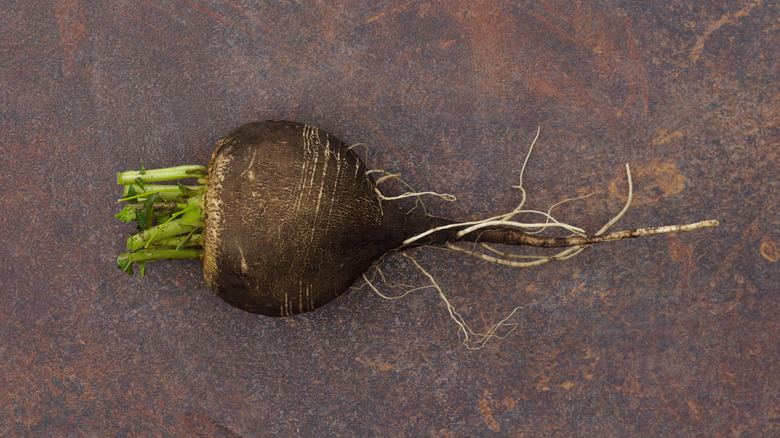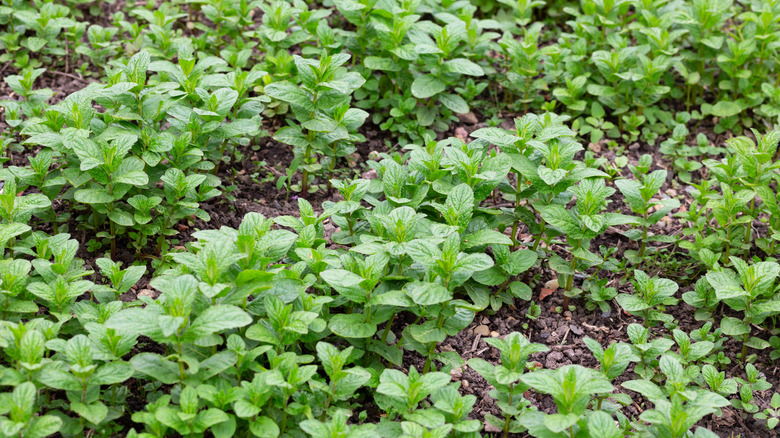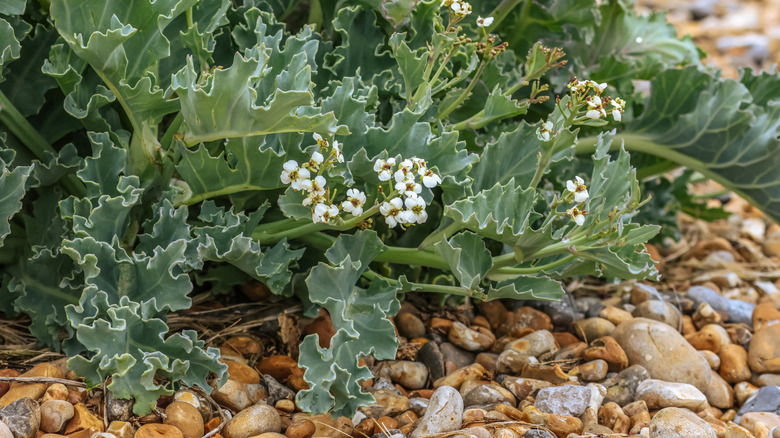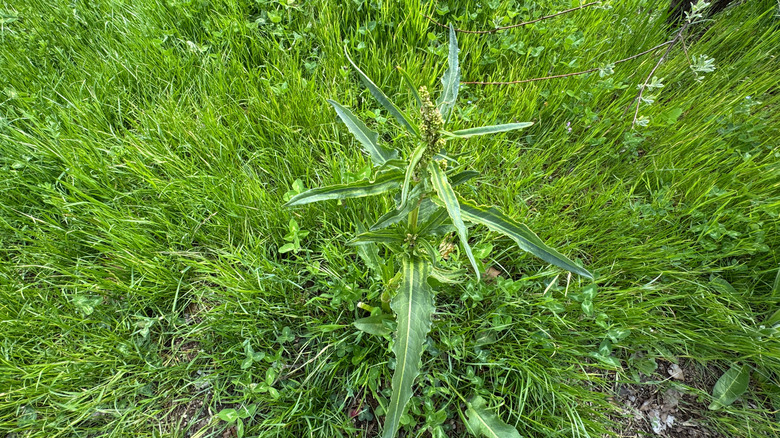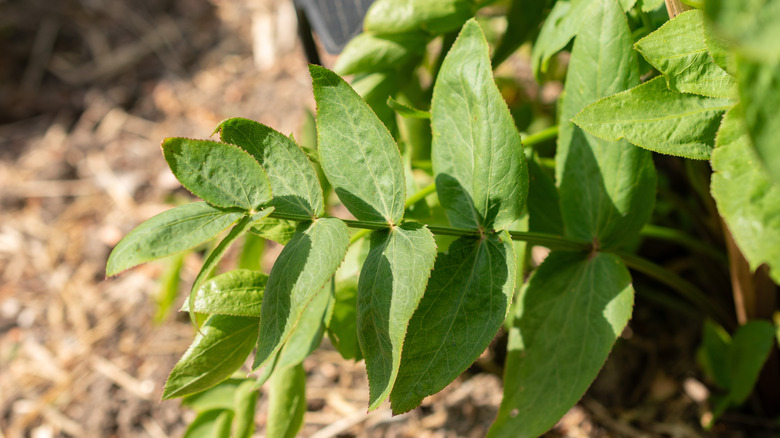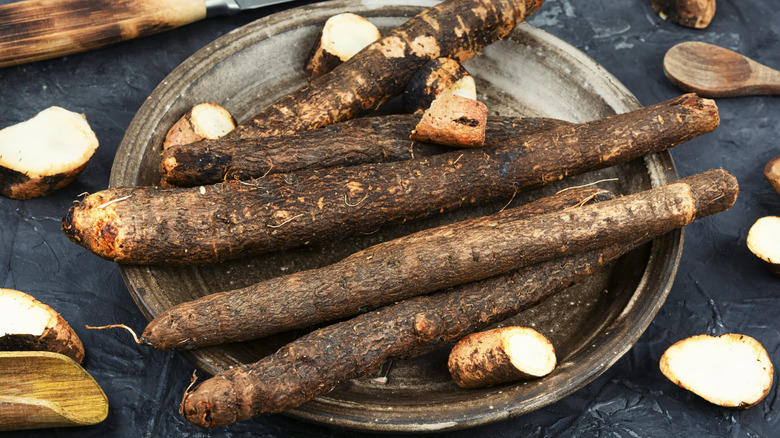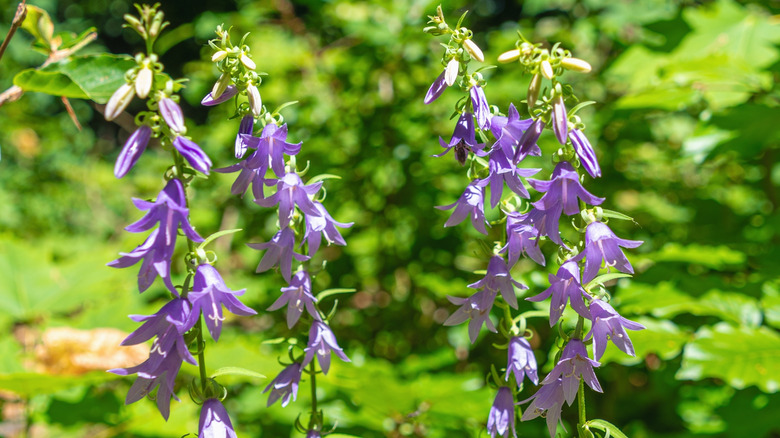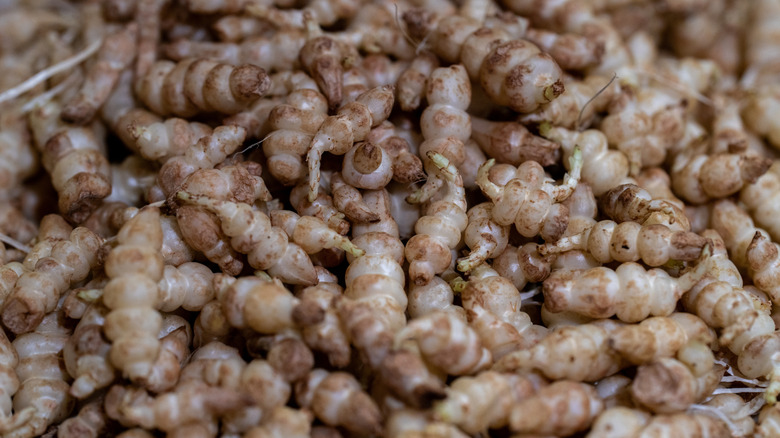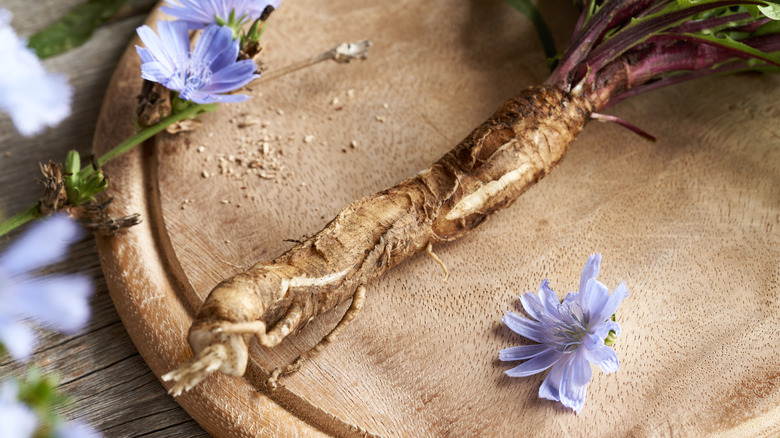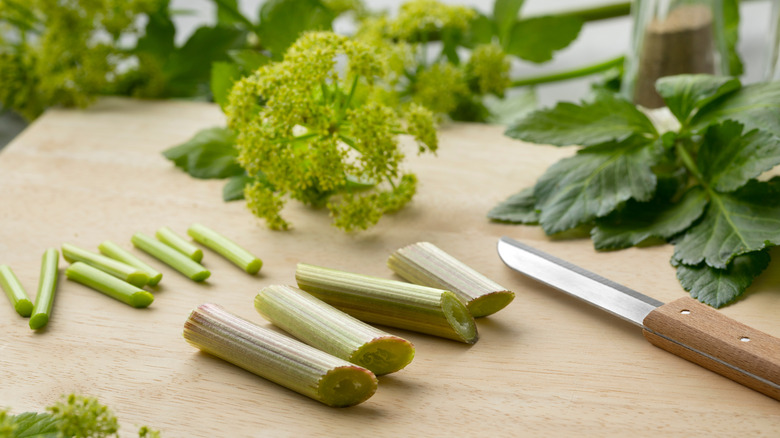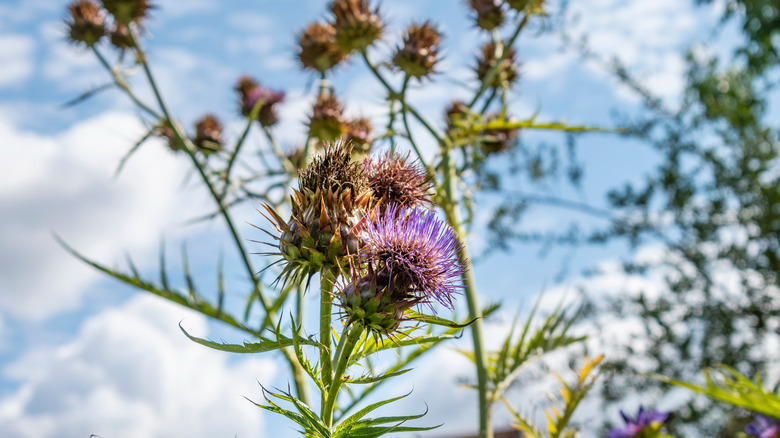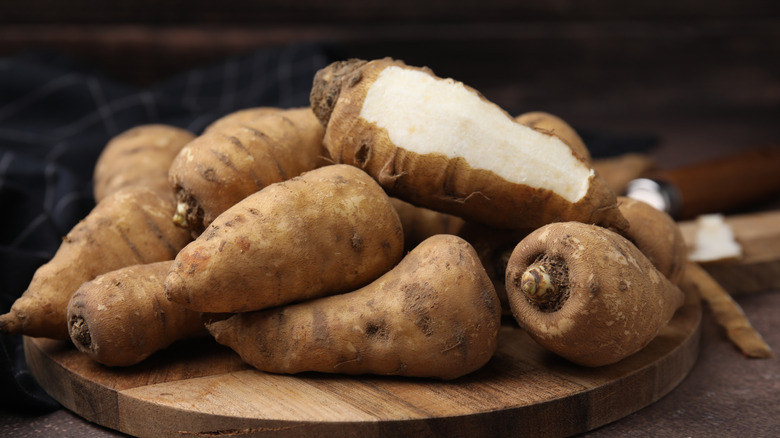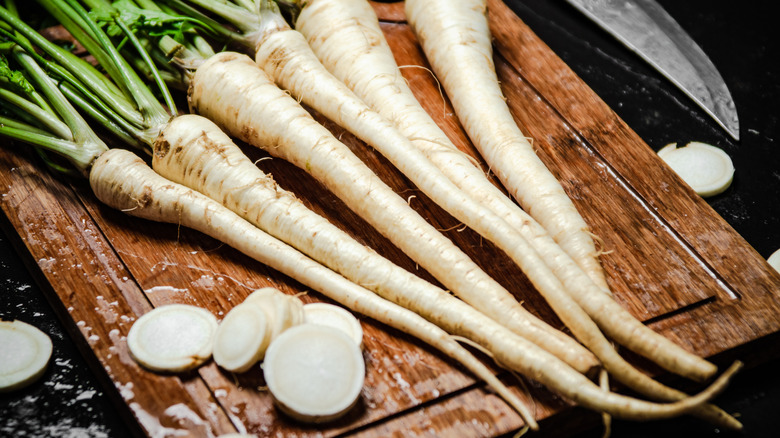15 Vegetables People Don't Really Eat Anymore
Once upon a time, our dinner tables looked a little different. Before supermarket shelves overflowed with glossy peppers and bagged salad mixes, people relied on a much wider range of vegetables, some quirky, some humble, and many that were more difficult to grow. These forgotten crops were staples in gardens and kitchens across the world, shaping local cuisines long before industrial agriculture streamlined our choices. Today, though, they've slipped into obscurity, overshadowed by easier, prettier, or longer-lasting alternatives.
Yet behind every faded vegetable lies a story of festive, seasonal meals, cooking traditions, and flavors that deserve a second chance. From roots that taste like chestnuts to coastal greens once prized by the Victorians, these plants remind us that lost doesn't always mean gone forever. In this list, we'll dig into some vegetables that people don't really eat anymore, and why it might be time to invite them back to the table.
Good King Henry
Good King Henry is not a king, it's a vegetable, and whether or not it's good depends on who you ask. This green was once a familiar sight in British kitchens, prized for its reliability and versatility. Often called "poor-man's asparagus" or "Lincolnshire spinach," it thrived with little care and returned year after year, making it a dependable source of fresh greens in a time when vegetables were scarce outside the growing season. It was a common part of the diet in the British Isles for centuries, only to fade from common use in the modern era as spinach and other greens rose in popularity.
The leaves have a bitter, earthy flavor, and to mellow it out before eating they can be rubbed with salt and cooked to yield a taste that's reminiscent of spinach but with a deeper, more rustic undertone. While the young leaves can be boiled or sautéed, the tender shoots that sprout in spring can be blanched and served like asparagus. Its resilience made it beloved by generations of gardeners, though today it is mostly grown by heritage enthusiasts or foraged.
Miner's lettuce
While most of the forgotten vegetables on this list have European origins, miner's lettuce is native to the western coast of North America, and it once played a crucial role in California's history. Indigenous peoples had long used it for medicinal purposes before Europeans arrived in the Americas. During the mid-19th-century California Gold Rush, prospectors discovered the plant as well and relied on it to ward off scurvy, thanks to its high vitamin C content. In fact, the name "miner's lettuce" reflects its importance to those who staked their fortunes on the California hills.
This delicate green is recognizable by its round, cup-shaped leaves that cradle the plant's tiny flowers. Its taste is crisp and juicy, like spinach but with the fresh crunch of lettuce. Traditionally eaten raw, it adds freshness to salads and sandwiches, though it can also be lightly steamed or wilted and used in soups and stews.
California doesn't have a state food, but this crisp green is a good unofficial contender since it's native to the region and played an important role in its history. Though easy to overlook beside more conventional salad greens, miner's lettuce is worth trying if you find yourself in the Golden State with an appetite for foraged food.
Black Spanish radish
Few vegetables have an appearance as striking as the Black Spanish radish, an heirloom root that once enjoyed widespread popularity across Europe. Records suggest it was grown as far back as the 16th century and by the early 1800s it had made its way to American soil, where it was cultivated alongside other hardy root vegetables. Its jet-black skin and snowy white interior along with its reputation for both culinary and medicinal uses secured it a steady following for centuries.
Beneath its rugged, dark exterior lies a crisp flesh with a strong, peppery bite that's notably sharper and more pungent than the common red radish. When sliced thin in salads or grated into slaws, it adds a lively, nose-tingling kick, while roasting or simmering it in soups softens its heat and brings out a mellow sweetness.
Beyond the table, it was long valued for its purported healing properties, particularly as a digestive aid and liver detoxifier. Before the advent of refrigerators, it was also popular in part because root vegetables, when stored correctly, are relatively shelf-stable. Although its popularity waned with the arrival of milder radish varieties, gardeners and chefs who seek out the Black Spanish radish today still prize it for its dramatic look and bold flavor.
Lovage
Lovage is a perennial herb that once dominated both kitchen and apothecary gardens across Europe. Known since Roman times, it was so prized that Charlemagne demanded its presence in gardens across his domain, where it flavored sauces and meat dishes. In the Middle Ages, it grew in monasteries, valued not only for its culinary uses but also for its medicinal reputation as a digestive and circulation aid. Today, it has mostly slipped into obscurity, remembered mainly by foragers and herb enthusiasts.
Lovage has a bold, concentrated flavor that bridges the brightness of parsley, the depth of celery, and the peppery intensity of anise. Every part of the plant can be eaten including the roots, seeds, and flowers, but leaves and stalks are most commonly used in the kitchen. The leaves can be chopped into soups and stews or sprinkled on top of potato salad like parsley and the stalks blanched and eaten like celery. Like other leftover herb stems, it can be used to flavor stocks and broths, lending a sharp, herbaceous note. For those who rediscover it, lovage still has the power to enliven a modern table.
Sea kale
Native to the shores of northern Europe, sea kale is a hardy coastal plant that once graced Victorian dining tables but is now largely forgotten outside of specialty gardens. The plant was cultivated in Britain for decades, where it was a fashionable delicacy and often served at elegant dinners. Its decline in popularity was more about shifting agricultural trends than it was about taste: Vegetables that required less effort to cultivate quickly outpaced it.
The plant itself has sweet-smelling white flowers and broad blue-green leaves that are harvested in spring since they grow more bitter as the season progresses. These leaves can be eaten much like regular kale, sautéed, blanched, or massaged with salt and paired with a perfect salad dressing to match the plant's unique flavor. Sea kale shoots were also often picked and eaten much like asparagus, offering a tender, nutty flavor. The plant's young flower buds resemble broccoli and can be cooked in similar ways. Victorian gardeners prized the practice of forcing sea kale under terracotta pots, which yielded pale, tender stems with a sweeter flavor that commanded high prices in markets.
If you see sea kale in the wild today, don't be tempted to bring it home. The plants were over-foraged, and the wild populations of sea kale that once graced the European coastline are still making a comeback.
Dock
Like many of the plants on this list, dock is somewhere between wild weed and a welcome vegetable. If you live in Europe or North America, chances are you've seen this plant many times without noticing it (I found some on a walk this morning). During the Great Depression in particular, families struggling to make ends meet foraged it in fields and ditches, turning its tangy leaves into a much-needed source of nourishment. Though often overlooked today, dock has been eaten in some form for centuries, its sour brightness offering variety in diets that could otherwise be heavy and bland.
Its flavor is distinctly zesty, a sharp sorrel-like tartness that comes from natural oxalic acid. Young leaves are tender and make excellent additions to meat, potatoes, or egg dishes, where their sourness cuts through richness. Older leaves toughen quickly and become more sour as they age, but even they can be boiled into a tangy pot herb or blended into soups and stew. The plant is a perennial, meaning its roots live underground throughout the winter and the plant sprouts up again each spring, offering copious quantities of sharp, lemony leaves.
Skirret
It's hard to imagine Europe without potatoes, but before the famed tuber conquered the continent, skirret was one of the region's favored root vegetables. A member of the carrot family, it was cultivated in Roman times and maintained its popularity for centuries. Its decline came gradually, as potatoes and parsnips proved easier to grow and store, pushing skirret out of the common diet and by the 20th century, it was virtually unknown.
The plant produces clusters of slender, white roots with a sweet, nutty flavor. When freshly harvested, they are crisp and juicy, somewhat resembling parsnips but with a sweeter finish. Skirret can be roasted, boiled, or stewed like carrots, and some recipes call for it to be made into fritters. Because the roots are narrow and sometimes fibrous at the core, preparation can be labor-intensive, which is one likely reason for its eventual fall from favor. Still, those who revive skirret today praise its unique, crisp, buttery flavor.
Salsify
Contrary to what you might think, salsify is not a verb, it's a root vegetable that was once a popular food in colonial America and across Europe. There are two types of salsify: White and black. Both long and slender, resembling a carrot, but white salsify has a tan color and more hairs while black salsify is dark brown with a smoother surface. When cooked, both types develop a delicate, nutty flavor with a hint of oyster, hence salsify's nickname "oyster plant."
The plant is native to Europe and was popular in Victorian era kitchens in England, especially in the winter when fresh veggies were harder to come by. It was brought to North America when the continent was colonized and became a hit in New England and the mid-Atlantic states. Salsify can be boiled and mashed with butter like potatoes, sliced it into soups, or fried into fritters.
After its moment in the sun, salsify gradually faded from cultivation as potatoes, carrots, parsnips, and other more robust root vegetables claimed center stage. Although it's largely fallen out of favor, there are some companies trying to re-introduce the vegetable back into the mainstream, and foragers can still find salsify plants growing wild on trails and roadsides.
Rampion
Once cultivated for its edible roots and leaves, rampion has been cultivated at least since the time of William Shakespeare, who mentioned it in some of his plays. And its cultural footprint extends even further: Rampion is a crucial plot device in the fairy tale "Rapunzel," which is the German name for this once beloved veggie.
The root of rampion is small, white, and tender, with a mild, nutty sweetness that made it a good candidate for roasting or boiling, much like a parsnip. Its leaves, by contrast, were eaten fresh in salads, offering a soft texture and pleasant, slightly bitter edge. The plant's tender shoots can be prepared like asparagus, delicious with olive oil, lemon, and sea salt. Gardeners also admired its delicate purple-blue flowers, which made rampion as beautiful as it was delicious. The rampion was root, leaf, and beauty all in one. While this gorgeous, tender veggie is still cultivated by some farmers in France, Germany, and Italy, it's generally fallen out of favor with mainstream cooks.
Chinese artichokes
Chinese artichokes, also known as crosnes, made a brief but glittering appearance in French cuisine during the first half of the 20th century. Originally cultivated in China, they were introduced to Europe in the late 19th century and quickly caught the attention of French chefs, who prized their unusual form and delicate taste. For a short period, they were considered a fashionable delicacy before fading into obscurity.
The tubers themselves are small, knobbly, and white, resembling tiny curled caterpillars. Their flavor is mild and nutty and unlike many other tubers, they retain their crunch after they're cooked. The texture is crisp yet tender, and despite the name, they are not related to globe artichokes. In France, they were often sautéed or glazed, allowing their subtle qualities to shine in refined preparations. Unfortunately, the species was affected by viruses after the Second World War and it became difficult to produce the vegetable on a viable commercial scale. Unlike some of the other vegetables on this list, however, crosnes has made a comeback thanks to the work of French food scientists.
Chicory root
If you're from New Orleans, you've definitely heard of chicory root. It was cultivated as far back as the days of ancient Egypt and was valued as a medicine that supported digestion, a claim supported by modern medicine. Its most famous chapter, however, came during the 19th century in Louisiana, when coffee divided the North and South during the Civil War. Locals were forced to stretch their dwindling coffee supplies, and by roasting and grinding chicory root as a substitute, they created a bitter, aromatic drink that developed into a regional tradition still enjoyed today.
The flavor of chicory root is robust, earthy, and slightly woody, with a bitterness that lingers on the palate. Brewed on its own, it produces a dark infusion similar to coffee but without caffeine and when it's blended with coffee, it deepens the roast's richness and softens acidity.
Historically, the root was also eaten boiled or roasted as a vegetable, while the leaves, which have an intense, bitter flavor, were served as salad greens. Nowadays, while it's still found in some New Orleans café au laits, it's no longer popular as a hearty veggie.
Alexanders
Once a common sight in gardens from ancient Rome to 17th century Britain, Alexanders was cultivated across much of Europe, where it thrived for centuries before gradually yielding to more modern crops like celery and parsley. In its heyday, however, it was celebrated as a versatile food plant, valued both for its flavor and as an herbal medicine to treat, among other things, scorpion bites and intestinal worms.
The plant resembles celery but offers a bolder, slightly peppery taste, with hints of parsley and lovage (another forgotten veggie). Young leaves can be used like parsley while roots could be roasted much like parsnips (the plant is a member of the carrot family). Even the seeds were used as a spice, lending a warming, aromatic note with a cumin-adjacent flavor.
For centuries, it was a staple in monastery gardens, grown by nuns who valued its abundance and intense flavor. Over time, however, the more delicate, refined flavor of celery displaced Alexanders, relegating it back into the wild where adventurous foragers can still find it today.
Cardoon
Cardoon is a robust, thistle-like perennial native to the Mediterranean, long cultivated both as a striking ornamental and for its edible stalks. Early civilizations like the Greeks, Romans, and Persians consumed it, and while it's still cultivated as a food in parts of Southern Europe and North Africa, it no longer enjoys the mainstream popularity it once did. In Victorian-era England and colonial North America, cardoon was admired for its foliage and its vibrant purple flowers that resemble artichoke flowers. It was once a widely consumed vegetable, though today it survives mainly in specialty markets and gardens.
Culinarily, cardoon offers a flavor reminiscent of the nutty, robust taste of artichoke. Its thick leaf stalks are traditionally blanched (by wrapping or covering to exclude light) to reduce bitterness and tenderize them, then prepared by braising or adding to stews. In many habitats where it was introduced, cardoon has become an invasive species and it's no longer cultivated as a veggie because it's so labor-intensive to harvest, but it can still be found decorating gardens from Spain to San Diego.
Chervil root
Though rarely encountered today, chervil root was long esteemed in Europe for its subtly sweet, nutty tubers. Native to Eastern Europe, it became a notable root vegetable in France's culinary history. The small, modest-looking roots develop a delicate, chestnut or parsnip-like flavor, especially after cold storage sweetens their starches into sugars. Chervil root is delicious when roasted or mashed, combined with other root vegetables, and paired with hearty meats like lamb and beef.
However, chervil root's challenging cultivation limited its widespread adoption. While the leaves are still sometimes used in herbes de Provence, the famous French culinary combo, the seed must be sowed in a particular way to avoid pests and the roots must be store for a few weeks before they can be, making large-scale farming impractical. Thanks to the pioneering efforts of the International Society for Horticultural Science, however, some strains of chervil have been developed that are easier to grow, which has recently made the veggie more popular in certain regions of France.
Parsley root
Parsley leaves are among the most common herbs in many kitchens these days, but the roots are virtually unknown by most tastebuds. Few people know that underneath the leafy garnish (which is related to regular parsley) is a root that resembles carrots and parsnips, and can be cooked in much the same way. For centuries it was a common vegetable in Western European cuisine, only to be nudged aside when other root veggies stole the spotlight.
At first glance, the root looks like a pale, skinny carrot with cream-colored flesh. While the root can be sliced raw and prepared for a crudité platter, when you cook it, it reveals a flavor reminiscent of a parsnip, but a little sharper and less sweet. The root maintains some degree of popularity in traditional Jewish and Eastern European cooking, and you can still find it in modern Polish, German, and Russian cuisine. While they're still delicious and beloved by some, parsley roots take a long time to grow and have a relatively short shelf life, which makes them harder to produce on a commercial scale.
